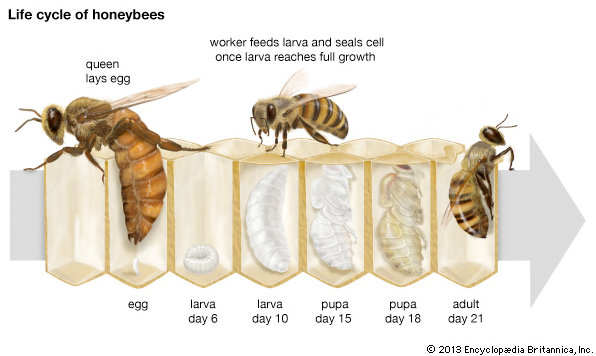As a beekeeping trainer and lecturer one of the things I like to stress is the importance of learning honey bee development timings. Here I explain the timelines – Why we need to know this information will be in the next blog.
For the purpose of this blog I will break down the honey bee castes into three, 1; Queen, 2; Workers, 3; Drones. I know some people say there are only 2 castes but lets stick to three to keep things simple. So lets start with the timelines first and look at the development times for each caste member.

Queen Bee – development stage – 16 days
The queen bees is the one single fertile member of the hive and is (usually) the mother of all the bees in the hive. During the summer months she can lay up to 1500 eggs in a day. She leaves the hive only twice in her lifetime. 1) to mate with 10-20 drones a few days into her life; 2) when leaving the hive with around half the workers during swarming.
The queens role is to keep the colony cohesion intact and to lay eggs which then become the hives next workforce. Without a queen the colony cannot continue. It Is therefore of no surprise that the development time of a queen is so short.
From the time an egg is laid until the a new queen emerges is 16 days. This means if a queen for some reason dies, the colony can create a replacement quickly. The new queen however still needs to go out and mate with multiple drones to become fertile, this can take between 1-3 weeks from emergence. The time it takes for a queen to mate is very weather dependant as mating takes place on the wing, fine warm weather means good flying weather. A downpour means mating will be delayed.
3 days as an Egg – A fertilised egg is laid by a queen into a prepared wax cell. Three days later the larvae emerges. Technically speaking the larvae does not ‘emerge’, the egg casing is absorbed into the larvae providing extra nutrients, a process unique to honey bees and known as eclose.
5 days Larvae stage – The emerged larvae now needs to be fed and is very hungry. It is fed a diet exclusively of Royal Jelly for 5 days ensuring it becomes a queen. On average a queen larvae is fed 1500 times over the 5 day period.
8 days – Pupae
The worker bees no longer have to feed the larvae so get to work capping the queen cell. Inside the cell the pupae transforms by metamorphoses into a fully formed queen emerging 8 days later
So 3 days an egg, 5 days a larvae (8 days so far), and another 8 days as a Pupae.

Worker bee development – 21 days
The worker bees make up the majority of the hives population and is the smallest bee in the hive. She performs the majority of the work and lives for up to 5-6 weeks in the summers and 5-6 months in Winter. Jobs done are dependant on age. As a young house bee, she cleans cells for the queen to lay in, then moves onto feeding the larvae, then feeds the queen. Once her wax glands become active she makes beeswax followed by receiving nectar from incoming foragers. At three weeks of age she spends some time defending the hive before becoming a forager bee.
When I was taught beekeeping over a decade ago one of my tutors gave me a extremely easy method of remembering the timings for the development timing of workers by doubling the last number of the last phase. So three days egg, double that to 6 days for Larvae and double again to 12 days for Pupa. Easy hey?
3 days as an Egg – Once again the egg takes 3 days to develop into a larvae
6 days as a Larvae – This once again is the feeding stage. For the first few days the larvae is fed Royal Jelly like the queen, then the diet is changed to include honey and pollen. This change of diet stops the larvae becoming a queen.
12 days as a pupae – During the worker bee pupation stage the pupa goes through a number of distinct changes before becoming a fully formed adult worker bee on day 21. A visual representation of the changes are shows above.

Drone bee development – 24 days
The Drone is the only male member of the hive and makes up around 10% of a colony in summer. He is the only member of bee hive colony allowed into any hive. The Drone has no stinger so is unable to defend the hive, he is also fed and cared for the the workers bees. So why does the hive tolerate and actively make drones? Well he carries the genetics of the queen (his mother) and mates with virgin queens from other hives. This ensures the hives genetics propagate, unfortunately for the drone he dies after mating.
He is produced from an unfertilised haploid egg (parthenogenesis) meaning he has no father but does have a mother (the queen which laid the egg). He does however have a grandfather (queens father).
3 Days as an Egg – As with the queen and worker, the development time for the egg to become a larvae is 3 days.
7 Days as a larvae – The drone has the logest time as a larvae.
14 days as a pupae – This is the longest development time, taking 2 weeks.

Remember
Egg stage -3 days for all castes
Queen 16 days = 8 days before the cell is capped and another 8 days before emergence
Worker 21 days total = just double the numbers – 3 days egg, 6 days larvae, 12 days pupae
Drone 24 days = 7 days as a larvae and double that for 14 days as pupae.
Honey Bee development – Timelines
I would encourage any beekeeper or potential beekeeper to learn the development timelines. The chart here gives a visual representation. Knowing these dates will help you in many aspects of management of a bee colony. This will be discussed in part 2 of this blog.

